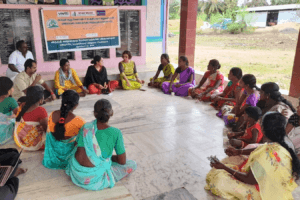The digitalization of land registries involves several challenges related to equal access and land sovereignty, the inclusion of customary rights, and citizen control over datasets
After India liberalized its economy in 1991, the country has been systematically digitalizing land registries on a massive scale with the aim of automating and securing land tenure. Digitalization has entailed many drawbacks: for example, it has failed to include the large variety of customary land systems in India and it has reinforced the pre-existing exclusion of marginalized farmers, tribal groups, and Indigenous peoples. AgriStack, a proposed government-backed data exchange in agriculture that enables the integration of digitalized land records with farmer profiles and other agricultural data, has opened the door to corporate access and takeover of these big datasets. This has served to reinforce the commodification of local knowledge, the appropriation of agriculture value chains, and the dispossession of farmers’ control over their data. Hence, in the present conjuncture, land and livelihood sovereignty has become enmeshed with data sovereignty. Technology does not override the power structures embedded in a society; rather, its trajectory is dependent on institutional choices. A pro-market, neoliberal technological path is likely to exacerbate long-standing inequalities. Therefore, digitalization must go hand in hand with land and human rights.
The central government’s Digital India Land Records Modernization Programme (DILRMP) has been conducting a fast-paced digitalization process of land records data in Jharkhand, and several tribal and Adivasi (aboriginal) groups are bearing the brunt of its poor execution. For example, in 2019, the inhabitants of Naya Toli, a hamlet in the Indian state of Jharkhand became homeless overnight. Mukesh Kujur1, a 27-year-old inhabitant of Naya Toli, has been waging a battle against the Jharkhand government for the past two years, after he and his fellow villagers of the Oraon tribe woke up one day to discover that their 108 acres of land, purchased in 1973 by 19 families, were no longer registered in their name, but had been recorded as belonging to the previous owner.
After receiving an unsatisfactory response from the state government regarding their appeal, the Naya Toli community have still been attempting to pay their land tax for the past two years, fearing that the state will eventually deny their claim to the land as a penalty for not paying their taxes. But this too has posed a challenge. When Kujurl went to the local Common Service Centre to pay Naya Toli’s annual tax in 2017, officials refused to let him proceed with the transaction, citing that the community no longer owns the land according to the newly introduced DILRMP records.
As of 2019, Jharkhand is one of the few states in India to have digitalized more than 99% of its land records. However, several experts criticize its execution: only 2.3% of land in Jharkhand was physically surveyed, much less than the national rate which is just shy of 6%. These inefficiencies especially impact marginalized tribal and Adivasi groups. Not only do these communities regularly deal with encroachment of their commons, but they also have to fight hard to gain recognition for their customary rights of ownership to land, which are often overridden by digitalized land records.
In 2021, it was announced that the land records digitalized under DILRMP would become the “core” of AgriStack, a government-backed data exchange in agriculture that enables the integration of digitalized land records with farmer profiles and other agricultural data of non-human origin (meteorological, soil health, hydrology, etc.) helmed by the Indian government’s Department of Agriculture, Cooperation and Farmers Welfare. The purported intent is to aid the creation of personalized, data-enabled support services along the agricultural value chain from production support, financing, and farmer advisories to marketing and consumer linkages downstream – in order to enhance farm productivity and farmer income.
AgriStack was proposed amidst one of the largest farmer protests in modern Indian history which galvanized after three farming laws were passed by the Indian Parliament in September 2020 opening up the Indian farming industry to corporations. Although the laws were repealed in November 2021, this groundbreaking struggle against the corporatization of agricultural value chains continues, with several people’s movements expressing concerns over the institutional design of the newly proposed AgriStack and how it facilitates inroads for Big Tech into food systems.
In 2019, the inhabitants of Naya Toli became homeless overnight because of the poor implementation of a fast-paced digitalization process of land records data in the state of Jharkhand

Farmer in India. / Brazil Topno

